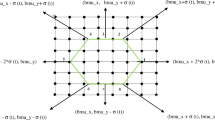Abstract
This paper reports the classification of 90 sample pavilions in Shanghai World Expo. An artificial intelligence based nonlinear clustering method known as Self-Organizing Map (SOM) has been used to classify expo pavilions. SOM is an efficient tool for visualization of multidimensional data. To conduct the classification, four characteristics namely Hurst exponent for queue length, Hurst exponent for waiting time, mean queue length and mean waiting time have been applied. The classification results show that Shanghai World Expo pavilions can be optimally classified into four classes. This result will shed light on further studies that how to manage the queue of World Expo pavilions in the future.
Similar content being viewed by others
References
Liang J K, Shanghai World Expo park management and service, Zhejiang Statistics, 2010, (8): 10–11.
Tsai C Y, Liou J J H, Chen C J, and Hsiao C C, Generating touring path suggestions using timeinterval sequential pattern mining, Expert Systems with Applications, 2012, 39(3): 3593–3602.
Zhou Z and Chen Y, Scale study of sites and pavilions for World Expo 2010, Frontiers of Architecture and Civil Engineering in China, 2008, 2(1): 102–106.
Yin R, Li K, and Yu J, Traffic forecast for visitiors in World Expo 2010 Shanghai Arena, Journal of Tongji University (Natural Science), 2007, 35(8): 1053.
Chao F and Guo J L, Visitor flow pattern of Expo 2010, Chinese Physics B, 2012, 21(7): 070209.
Zhou Y, Wang J, Huang D, and Sun S, Pedestrian simulation modeling for World Expo 2010 shanghai, Journal of Transportation Systems Engineering and Information Technology, 2009, 9(2): 141–146.
Wang D, Ma L, and Zhu W, Research of Pedestrian Flow in the World Expo 2010 Shanghai Based on Internet Survey, Urban Planning Forum, 2006, 3: 58–63.
Jin L, Simulation of congestion of visitors moving in 2010 Shanghai Expo, E-Business and Information System Security, EBISS’09 International Conference on: IEEE, 2009, 1–5.
Gu J F, Xu S Y, Fang Y, Shi K, Wang B, Song L, and Xie R, Shanghai World Expo and queuing service system, in Service Systems and Service Management (ICSSSM), 2013 10th International Conference on: IEEE, 2013, 1–3.
Gu J F, Xu S Y, Fang Y, Shi K, Wang B, Song L, and Xie R, Study on the collective behaviors of queuing in the Shanghai World Expo, Journal of University of Shanghai for Science and Technology, 2011, 33(4): 312–320.
Gu J F, Xu S Y, Fang Y, Shi K, Wang B, Song L, and Xie R, Queuing problems in Shanghai World Expo, Social Dynamics, Series on Social Physics, 2011, (3): 10–29.
Borge-Holthoefer J, Banos R A, Gonzalez-Bailon S, and Moreno Y, Cascading behaviour in complex socio-technical networks, Journal of Complex Networks, 2013, 1(1): 3–24.
Kohonen T, The self-organizing map, Proceedings of the IEEE, 1990, 1464–1480.
Mangiameli P, Chen S K, and West D, A comparison of SOM neural network and hierarchical clustering methods, European Journal of Operational Research, 1996, 93(2): 402–417.
Kohonen T, Hynninen J, Kangas J, and Laaksonen J, Som pak: The self-organizing map program package, Report A31, Helsinki University of Technology, Laboratory of Computer and Information Science, 1996.
Jain A K and Dubes R C, Algorithms for Clustering Data, Prentice-Hall, Inc., 1988.
Hurst H, Long-Term Storage Capacity of Reservoirs, Transactions of the American Society of Civil Engineers, 1951, 116(1): 770–799.
Bassingthwaighte J B, Raymond G M, Evaluating rescaled range analysis for time series, Annals of Biomedical Engineering, 1994, 22(4): 432–444.
Vesanto J and Alhoniemi E, Clustering of the self-organizing map, IEEE Transactions on Neural Networks, 2000, 11(3): 586–600.
Vesanto J, Himberg J, Alhoniemi E, and Parhankangas J, Self-organizing map in Matlab: The SOM toolbox, Proceedings of the Matlab DSP Conference, 1999, 16–17.
Author information
Authors and Affiliations
Corresponding author
Additional information
This research was supported by 973 Research Program under Grant No. 2010CB731500, the National Natural Science Foundation of China under Grant Nos. 71403262, 91024010, 91324009, Innovative Team Program under Grant No. GH13041 and Major Program of Institute of Policy and Management, Chinese Academy of Sciences under Grant No. Y201201Z06.
This paper was recommended for publication by Editor ZHANG Xun.
Rights and permissions
About this article
Cite this article
Li, Q., Gu, J. World Expo 2010 pavilions clustering analysis based on self-organizing map. J Syst Sci Complex 29, 1089–1099 (2016). https://doi.org/10.1007/s11424-015-4167-0
Received:
Revised:
Published:
Issue Date:
DOI: https://doi.org/10.1007/s11424-015-4167-0




